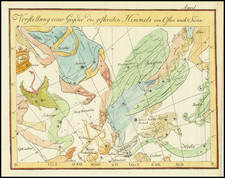This image represents a detailed lunar map from circa 1900, showcasing the moon's surface with a level of detail that reflects the astronomical knowledge and cartographic techniques of the era. The map displays a rich tapestry of lunar features, with meticulously labeled craters, maria (dark plains), and mountain ranges, all situated against a grid system that denotes lunar coordinates.
In the periphery of the main lunar map, several insets provide additional context and detail. One depicts a landscape of the moon as it appears during the setting sun, based on the observations of the astronomer Schmidt, which brings out the relief and shadows of the craters and terrain. Another inset illustrates a "Normal Moon Crater" as defined by the astronomers Nasmyth and Carpenter, giving a sense of the typical structure and depth of lunar craters.
The map also includes a comparative scale showing the greatest elevations of both terrestrial and lunar mountain masses, highlighting peaks such as Alps, Caucasus, and Apennines on the moon, juxtaposed with the Earth's Mount Everest for scale. The "Environs of the new Craters in the vicinity of Hyginus" provides a close-up of a specific lunar region, allowing for a more detailed inspection of the moon's geography.
Practical details such as the "mean distance of the Moon from the Earth" and the "Diameter of the Moon" are presented, giving a quantitative understanding of the moon's size and its relation to Earth. The bottom of the map includes a reference scale in English miles, offering a sense of the vast distances that separate the features on the lunar surface.









![[Cepheus]](https://storage.googleapis.com/raremaps/img/small/83186.jpg)
![[ Ara ]](https://storage.googleapis.com/raremaps/img/small/61712.jpg)

![[Lupus and Centarus]](https://storage.googleapis.com/raremaps/img/small/74171.jpg)

![[ Cygnus ]](https://storage.googleapis.com/raremaps/img/small/83197.jpg)